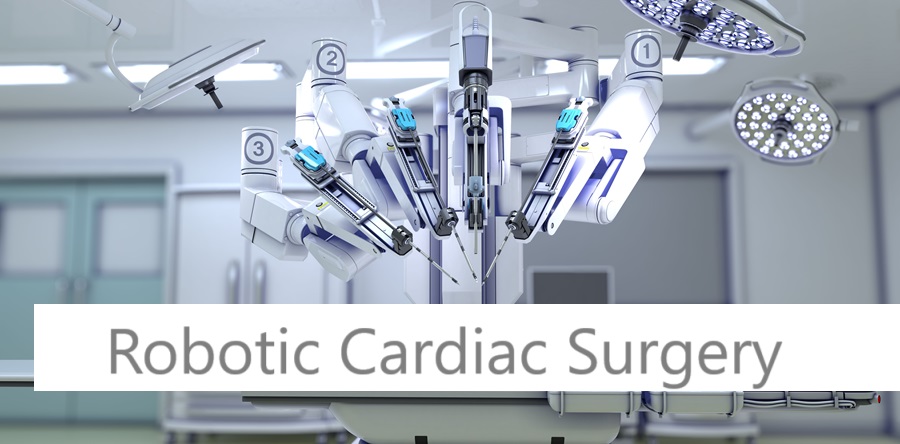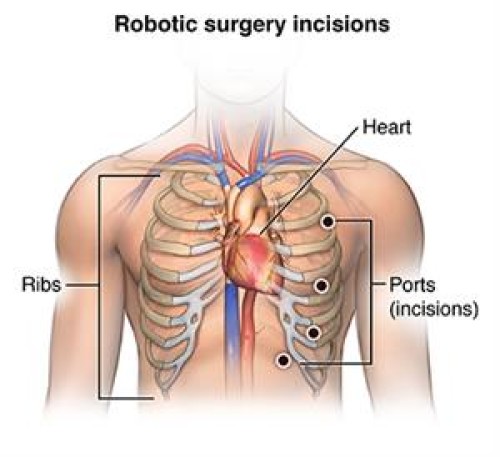Robotic cardiac surgery

What is Robotic Cardiac Surgery?
Robotic cardiac surgery is a modern technique for performing heart surgery through very small cuts in the chest, utilizing tiny instruments and robot-controlled tools. This approach is significantly less invasive than traditional open-heart surgery. The procedure is often called da Vinci surgery, named after the robot manufacturer frequently used in these operations.

Revolutionizing Heart Care
Cardiac surgery has undergone a remarkable transformation over the past few decades, with technological advancements continually pushing the boundaries of what is possible. One of the most significant developments in this field is robotic cardiac surgery. This minimally invasive technique utilizes robotic systems to assist surgeons in performing complex heart procedures with greater precision, reduced trauma, and faster recovery times for patients. In this blog, we will explore the history, technology, benefits, challenges, and prospects of robotic cardiac surgery.
The Evolution of Cardiac Surgery
Cardiac surgery has a storied history, with early attempts dating back to the 19th century. However, it wasn't until the mid-20th century that significant progress was made, thanks to innovations like the heart-lung machine and cardiopulmonary bypass. These advancements enabled surgeons to perform open-heart surgeries, which were previously considered impossible.
Despite these breakthroughs, traditional open-heart surgery is highly invasive, requiring large incisions and spreading of the rib cage, leading to prolonged recovery times and significant postoperative pain. This paved the way for minimally invasive techniques, which aimed to reduce the physical impact on patients.
The Advent of Robotic Surgery
Robotic surgery emerged in the late 20th century as a groundbreaking innovation in the medical field. The first FDA-approved robotic surgical system, the da Vinci Surgical System, was introduced in 2000. Initially used for urological and gynecological procedures, its application quickly expanded to other surgical specialties, including cardiac surgery.
The da Vinci system consists of three main components: a surgeon console, a patient-side cart with robotic arms, and a high-definition 3D vision system. Surgeons operate the robotic arms from the console, which translates their hand movements into precise micro-movements of the surgical instruments. This setup allows for unparalleled dexterity and control, surpassing the limitations of human hands.
Who need robotic cardiac surgery?
The main benefit of robotic cardiac surgery is that it is minimally invasive compared with open-heart surgery. Smaller incisions mean that you can heal faster and return to activities more quickly.
Your healthcare provider may recommend robotic cardiac surgery if you need an artery bypass procedure to improve blood flow to the heart. It may also be used to:
- Repair or replace stiff or leaky heart valves
- Correct atrial fibrillation, a common type of arrhythmia
- Remove a tumor in the heart
- Treat congenital heart conditions
Advantages of Robotic Cardiac Surgery
- Minimally Invasive: One of the primary benefits of robotic cardiac surgery is its minimally invasive nature. Instead of a large chest incision, surgeons make several small incisions through which the robotic instruments and camera are inserted. This approach reduces trauma to the chest wall, leading to less pain and faster recovery.
- Enhanced Precision: The robotic system provides a high level of precision and control, enabling surgeons to perform intricate maneuvers with ease. This is particularly crucial in delicate cardiac procedures where millimeter accuracy can make a significant difference.
- Improved Visualization: The 3D high-definition vision system offers a magnified view of the surgical field, allowing surgeons to see structures in greater detail. This enhanced visualization aids in identifying critical anatomical landmarks and avoiding potential complications.
- Reduced Blood Loss: Smaller incisions and precise instrument control result in less tissue trauma and reduced blood loss during surgery. This not only minimizes the need for blood transfusions but also lowers the risk of infection.
- Shorter Hospital Stay: Patients undergoing robotic cardiac surgery typically experience shorter hospital stays compared to traditional open-heart surgery. This is due to the reduced physical trauma, quicker recovery times, and lower incidence of complications.
- Faster Recovery: The minimally invasive nature of robotic surgery allows patients to return to their daily activities sooner. This is particularly beneficial for elderly or high-risk patients who may have difficulty tolerating the extended recovery period associated with open-heart surgery.
Common Robotic Cardiac Procedures
Robotic cardiac surgery can be used to perform a variety of procedures, including:
- Coronary Artery Bypass Grafting (CABG): In cases of severe coronary artery disease, CABG is performed to bypass blocked arteries and restore blood flow to the heart. Robotic-assisted CABG involves creating small incisions and using the robotic system to graft new blood vessels.
- Mitral Valve Repair and Replacement: Mitral valve disorders, such as regurgitation or stenosis, can be treated using robotic surgery. Surgeons can repair or replace the mitral valve with greater precision, resulting in improved valve function and patient outcomes.
- Atrial Septal Defect (ASD) Repair: ASD is a congenital heart defect characterized by a hole in the wall between the heart's upper chambers. Robotic surgery allows for precise closure of the defect with minimal invasion.
- Arrhythmia Surgery: Conditions like atrial fibrillation can be treated with robotic-assisted procedures, including the creation of scar tissue to disrupt abnormal electrical pathways and restore normal heart rhythm.
Challenges and Limitations
While robotic cardiac surgery offers numerous benefits, it is not without challenges and limitations:
- High Cost: The initial investment in robotic surgical systems and the associated maintenance costs can be substantial. This can be a barrier for smaller healthcare facilities or those with limited budgets.
- Learning Curve: Surgeons require extensive training and experience to become proficient in robotic-assisted procedures. The learning curve can be steep, and not all surgeons may have access to training programs.
- Limited Availability: Robotic surgery is not universally available, particularly in rural or underserved areas. Patients in these regions may not have access to the latest advancements in cardiac care.
- Procedure-Specific Limitations: Not all cardiac procedures can be performed robotically. Some complex or high-risk cases may still require traditional open-heart surgery.
The Future of Robotic Cardiac Surgery
The future of robotic cardiac surgery is promising, with ongoing advancements poised to further enhance its capabilities and accessibility. Some key areas of development include:
- Artificial Intelligence (AI) Integration: AI has the potential to revolutionize robotic surgery by providing real-time analytics, predictive modeling, and decision support. This could enhance surgical planning, optimize outcomes, and reduce the risk of complications.
- Telemedicine and Remote Surgery: The integration of telemedicine with robotic surgery could enable remote consultations and even remote surgical assistance. This would be particularly beneficial for patients in remote or underserved areas, providing them with access to specialized care.
- Smaller and More Versatile Robots: Future robotic systems may become smaller, more versatile, and capable of performing a wider range of procedures. This could expand the applications of robotic surgery beyond its current scope.
- Enhanced Training Programs: As robotic surgery becomes more prevalent, the development of standardized training programs and simulation-based education will be crucial. This will ensure that a larger number of surgeons can become proficient in robotic techniques.
- Improved Affordability: As technology advances and becomes more widespread, the cost of robotic surgical systems is likely to decrease. This could make robotic cardiac surgery more accessible to a broader range of healthcare facilities and patients.
India is home to several world-class cardiac hospitals in India that offer robotic cardiac surgery. These hospitals are equipped with advanced technology and staffed by highly skilled surgeons. Here is a list of the top 10 hospitals in India known for their excellence in robotic cardiac surgery:
- All India Institute of Medical Sciences (AIIMS), New Delhi
- AIIMS is one of the most prestigious medical institutions in India, offering cutting-edge robotic cardiac surgery in India performed by some of the country’s leading cardiac surgeons.
- Its reputation for excellence in medical education, research, and patient care ensures that it remains at the forefront of advanced cardiac treatment options.
- Fortis Escorts Heart Institute, New Delhi
- Known for its state-of-the-art infrastructure and experienced cardiac surgeons, Fortis Escorts Heart Institute is a leader in robotic cardiac procedures.
- The institute's dedication to innovation and excellence in cardiac care ensures that patients receive top-notch treatment using the latest robotic cardiac surgery in India
- Apollo Hospitals, Chennai
- Apollo Hospitals is renowned for its advanced medical facilities and highly experienced cardiac team, making it a top choice for robotic cardiac surgery in India.
- Apollo Hospitals is renowned for its advanced medical facilities and highly experienced cardiac team, making it a top choice for robotic cardiac surgery. The hospital's commitment to utilizing the latest technology and its focus on providing high-quality cardiac care ensure that patients receive the best possible outcomes.
- Max Super Speciality Hospital, Saket, New Delhi
- Max Hospital in Saket is equipped with the latest robotic surgery technology and has a team of expert cardiac surgeons dedicated to minimally invasive procedures.
- Robotic cardiac surgery in India is a highly advanced technology, and Max Hospital is indeed one of the best cardiac hospitals in India, recognized as a pioneer in this field.
- Max Hospital's dedication to adopting cutting-edge technology and its team of expert cardiac surgeons make it a leader in providing minimally invasive heart surgery solutions. The hospital's commitment to excellence in cardiac care has positioned it at the forefront of robotic cardiac surgery in India.
- Medanta - The Medicity, Gurugram
- Medanta is a multi-specialty hospital with a focus on advanced cardiac care, including robotic cardiac surgery in India, performed by a team of highly skilled surgeons.
- Medanta's commitment to excellence and innovation in cardiac care makes it a leading institution for minimally invasive heart procedures.
- Narayana Health (Narayana Hrudayalaya), Bengaluru
- Narayana Health is known for providing high-quality cardiac care at an affordable cost, with a strong emphasis on robotic cardiac surgery.
- Their focus on making advanced cardiac treatments accessible ensures that a broader population can benefit from cutting-edge medical technology and expertise.
- Kokilaben Dhirubhai Ambani Hospital, Mumbai
- This hospital boasts cutting-edge technology and a team of renowned cardiac surgeons specializing in robotic procedures, making it a top destination for cardiac care.
- Kokilaben Hospital started the Centre for Robotic Surgery in 2012 and within a short span has completed more than 1800 surgeries. In continuation with the momentum, we present our second cutting-edge Robot da Vinci Xi- the next frontier for minimally invasive surgery.
- Manipal Hospitals, Bengaluru
- Manipal Hospitals is recognized for its excellence in healthcare, with a dedicated cardiac center offering advanced robotic surgery options.
- Our robotic surgery procedure and treatment options are at par with international standards. The team approach, service, experience, state-of-the-art technology, treatment expertise and patient care rendered is highly applauded by all.
- Asian Heart Institute, Mumbai
- Asian Heart Institute is a premier cardiac care center in India, known for its expertise in robotic cardiac surgery and comprehensive heart care services.
- Jaypee Hospital, Delhi
- Jaypee Hospital is equipped with modern medical technology and has a team of expert cardiac surgeons, making it a leading center for robotic cardiac surgery in India.
These hospitals are renowned for their state-of-the-art facilities, experienced surgeons, and commitment to providing the highest quality of cardiac care through advanced robotic surgery techniques.
Conclusion
Robotic cardiac surgery represents a significant leap forward in the field of heart care. Its minimally invasive approach, enhanced precision, and improved patient outcomes make it a valuable tool in the hands of skilled surgeons. While there are challenges to overcome, the future of robotic cardiac surgery is bright, with ongoing advancements set to further revolutionize the way we treat heart conditions. As technology continues to evolve, patients can look forward to safer, more effective, and less invasive cardiac procedures that offer faster recovery and improved quality of life.